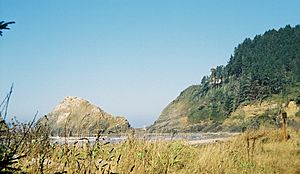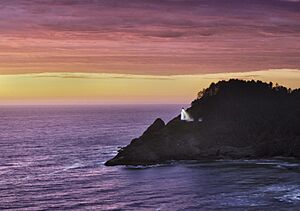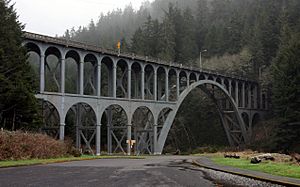Heceta Head facts for kids
Heceta Head is a tall piece of land that sticks out into the Pacific Ocean in Oregon, United States. It rises about 300 meters (1,000 feet) above the water. On its south side, you can find the famous Heceta Head Light, which is a lighthouse.
This headland is named after Bruno de Heceta. He was a Basque explorer who worked for Spain. He explored the Pacific Northwest in the 1770s. Heceta Head marks where sandy beaches end to the south. To the north, the coastline looks very different. A nearby area called Devils Elbow Bay is now part of the beautiful Heceta Head Lighthouse State Scenic Viewpoint.
Contents
Exploring Heceta Head's History
Heceta Head is home to several important old structures. These include the lighthouse, a house where the assistant lighthouse keepers lived, and two bridges. All of these are listed on the National Register of Historic Places. This means they are important historical sites.
The Famous Heceta Head Lighthouse
The Heceta Head Light is a lighthouse built in 1894. It stands about 62 meters (205 feet) up on the headland. The lighthouse itself is 17 meters (56 feet) tall. Its powerful light can be seen up to 34 kilometers (21 miles) out at sea! This makes it one of the brightest lights along the Oregon Coast.
Bridges Near Heceta Head
Two important bridges are also close to Heceta Head. The Big Creek Bridge carries U.S. Route 101 over Big Creek. This bridge is about 3 kilometers (2 miles) north of the headland.
The Cape Creek Bridge also carries U.S. Route 101. It crosses Cape Creek just south of Heceta Head. This bridge was the first in the world to have a special zinc coating sprayed over its entire structure. This coating helps protect the bridge.
How Heceta Head Was Formed
Heceta Head has an interesting geological past. Scientists believe it is either an old volcano that is no longer active, or it is the end of a very old lava flow. This lava flow came from a huge volcanic event called the Columbia River Basalt Group. This means the land here was shaped by powerful forces from deep inside the Earth!




